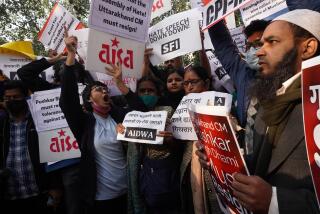Ancient Traditions Plague the Untouchables : India: They are the lowest of the low and often the victims of abuse because of their caste.
- Share via
NEW DELHI — Mohan Lal fled his village 13 years ago to escape the insults that were part of life as a Hindu without a caste.
When he returned home earlier this summer, Lal found that his family and other casteless people still were pariahs of the village in Rajasthan state.
Caste Hindus do not allow “outcastes,” as they are called, to wear shoes, ride bicycles, use umbrellas, drink from the main village well or hold their heads up while walking in the street.
Dozens of other rules ostracize the 100 million Harijans--untouchables who do not belong to any of the four castes recognized by the Hindu religion. The four Hindu castes determine a person’s social position by birth: the Brahmins, or priests; Kshatriyas, or soldiers, governors and landowners; Vaishyas, or tradespeople and farmers, and Shudras, or craftspeople and menial workers. Each caste has many subdivisions.
“We are treated worse than dogs,” said Lal, 28, now a construction supervisor in New Delhi.
Harijans have suffered for centuries under the rigid Hindu caste system, and the oppression is compounded by poverty and illiteracy. Most Harijans are agricultural laborers who are lucky to earn enough for two meals a day.
Sociologists and social activists say the subjugation of Harijans in this nation of 880 million is perpetuated by politicians because the untouchables provide useful “vote banks” during elections.
Harijans means “children of God,” in Hindi. Mohandas K. Gandhi gave untouchables the name in hope it would provide them some respectability.
The practice of untouchability was declared illegal after independence from Britain in 1947, but it continued unchecked.
Politicians rarely talk about the problems of untouchables. Welfare Minister Ram Vilas Paswan, a Harijan himself, acknowledged in Parliament in May that he did not know how many untouchable victims of violence had been aided by the government.
Paswan said authorities had been “asked to take appropriate action both to punish the perpetrators of crimes and to provide appropriate relief and rehabilitation to the victims.”
The government says 14,269 cases of atrocities against Harijans were recorded in 1989, including 759 rapes and 479 murders.
One Harijan laborer was burned to death April 5, allegedly by his upper-caste village landlord. The case was publicized because the victim was a resident of Prime Minister V.P. Singh’s constituency of Fatehpur in the northern state of Uttar Pradesh.
The landlord belonged to Singh’s subcaste, the Thakurs, who are part of the Kshatriya caste.
Members of the opposition Congress Party raised the issue in Parliament and brought the victim’s widow to New Delhi.
“V.P. Singh should be sent to jail because he is trying to protect the killers,” said Kanshi Ram, president of the Majority People’s Party.
Ram, born into the Sikh religion, said the crime in Fatehpur was not unusual.
His party is the only one in India that speaks for the Harijans. He said they and tribespeople, who also are outside the caste system, make up 25% of the population and the lower castes are another 50%.
Despite such a large reservoir of potential support, the Majority People’s Party is strong only in some districts of northern India. Harijans, uniformly distributed through the country, do not have a common political organization.
No minister or welfare official has made a public statement about the lack of progress in solving the problem of untouchability, but many say privately it is endemic and too big to be solved by the government.
According to Hindu belief, caste Hindus are defiled by touching a Harijan and water becomes polluted if a Harijan walks past the well.
Such beliefs took root about 2,500 years ago and remain widespread in Indian villages, where 75% of the people live, according to sociologists.
“In villages, they can’t use umbrellas, wear new clothes or ride bicycles in the presence of caste Hindus,” said Kailash Satyarthi, a social activist. “Harijans are beaten up for this, their women raped and men sometimes killed.”
Politicians guard the status quo because economic and educational progress would “open the eyes of the Harijans,” Satyarthi said.
Social activists say politicians use the lack of leadership to perpetuate divisiveness among those of no caste.
“There is a lack of awareness and coordination among the Harijans. There is no mass consciousness. Harijans are a group by itself, but they are not a group for itself,” said T.K. Oomen, a sociologist.
“The Harijans are splintered across political parties, and each group is something like a politician’s personal borough,” Oomen said.
More to Read
Sign up for Essential California
The most important California stories and recommendations in your inbox every morning.
You may occasionally receive promotional content from the Los Angeles Times.













